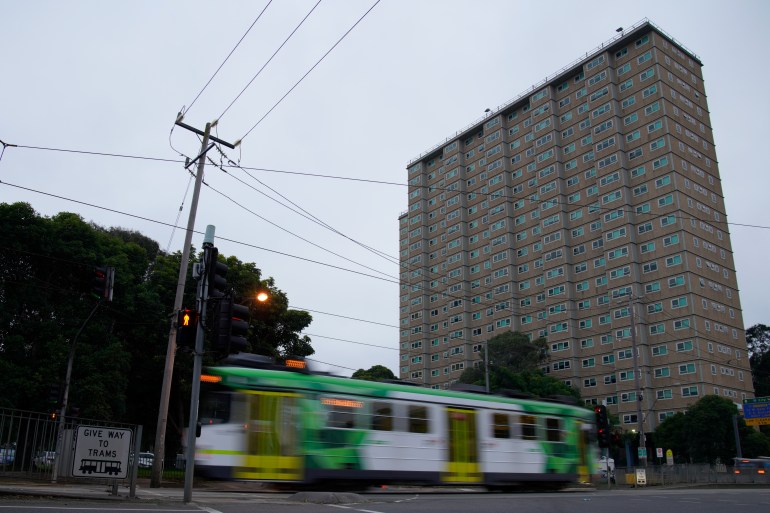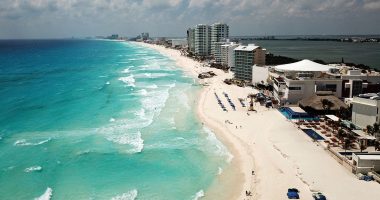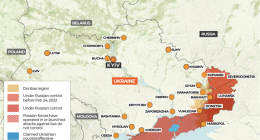Melbourne, Australia – The residents of dozens of public housing towers in the southern Australian city of Melbourne heard the state government was planning to demolish their homes on the news.
“Everyone found out from the TV, from the news, with the rest of Victoria,” Sara*, a resident of the first group of towers to be knocked down, told Al Jazeera.
Sara’s home, among a cluster of 14-storey towers in the inner-city suburbs of Flemington, North Melbourne and Carlton, will be one of the first to go after the Victorian government last year announced its plan to demolish all 44 of the state’s remaining public housing towers.
Built under public housing schemes in the 1960s, the blocks are located in parts of the city closely eyed by property developers as Melbourne’s house prices continue to soar.
The Victorian government has described the plan, announced as part of a wider Housing Statement in September 2023, as “Australia’s biggest ever urban renewal project”.
In total, about 10,000 people are facing relocation as a result of the demolition scheme.
But for residents of the first towers to face the wrecking ball, the project has offered little reassurance.
“They’re not telling us what they’re going to do, what their plan is,” Sara told Al Jazeera. It’s been “very unclear, and not very transparent”.
The lack of information has left residents unsure where they will end up and concerned they will be separated from the communities they have built with their neighbours.
“I grew up in this area, so it’s a special place for me,” said Sara, adding that there is a “huge sense of community” among the people who live in her building.
“Raising my family here and being around the community – it means a lot. And to think about the demolition and what that means in the long term, it’s really heartbreaking to think about.”
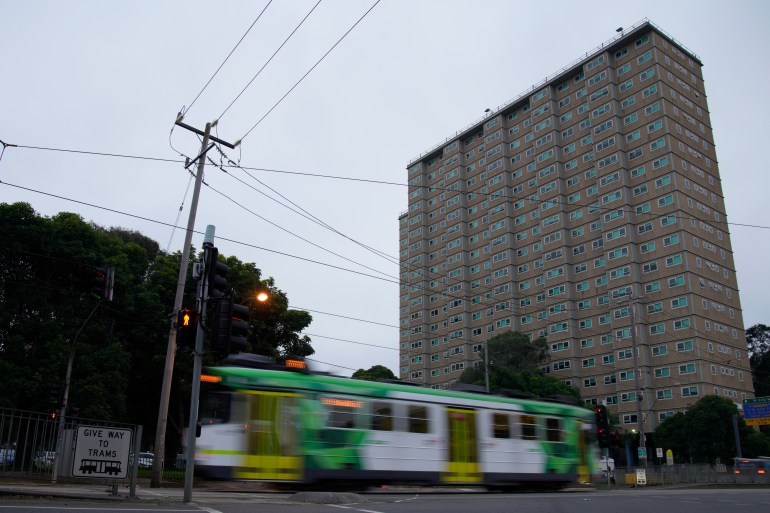
Residents in the flats have launched a class action suit against the government’s plan. The lead plaintiff in the suit lodged by the Inner Melbourne Community Legal (IMCL) is Barry Berih, who is also from the first group of towers slated for demolition.
“We are still being kept in the dark,” Berih said in a statement when the case was launched. “I don’t know where I am going to be living or where I might end up, and the government isn’t giving us the information we need to make decisions.”
The state government has applied to throw the suit out, and the Supreme Court is set to hear the case on Tuesday. The IMCL says it is another attempt by the government to avoid accountability over its decision.
“The public housing estates aren’t just bricks and mortar that belong to the state government,” IMCL’s managing lawyer, Louisa Bassini, said in a statement on Monday. “The towers are home to 10,000 Victorians and their rights matter. Their homes, families and communities are important. The Victorian Government should not prefer expedited and secretive decision-making ahead of proper consideration of peoples’ rights.”
‘Dedicated engagement’
The demolition plan is not the first time residents of the public housing towers have had their lives turned upside down by an abrupt state government announcement.
Late in the afternoon on July 4, 2020, as the COVID-19 pandemic raged, then-Premier Daniel Andrews announced the public housing towers in Flemington and North Melbourne would be locked down with immediate effect.
Unlike people living in private homes across the street, the 3,000 public housing tenants were given no notice of the lockdown and were not permitted to go outside to buy essential items at the supermarket or pharmacy.
Instead, police were sent to the buildings and stationed in the lifts and lobbies.
A government ombudsman later found the “immediate detention” violated the residents’ human rights and “was not based on direct health advice”.
Despite the ombudsman’s findings, Sara says the announcement the towers would be knocked down, a little more than three years later, felt eerily familiar.
“For me personally and I’m sure for many people, it was really triggering. It took us back to the hard lockdown,” she said. “The only thing missing from the crowd was the cops. We were the ones that were locked down and we’re the first lot to go. It kind of feels personal at this point.”
A spokesperson from the government said they were limited in what they could say about the redevelopment scheme while the matter was before the courts but said a “dedicated engagement team” had visited all “5,800 households across the towers to make sure every resident has the support they need and their questions answered” and that residents were also offered consultation through “pop-up up stalls”.
The consultation process included 150 interpreters “to ensure residents”, many of whom are from refugee or migrant backgrounds, “could be heard in their primary language”, the spokesperson added.
But Bassini says consultation could have begun earlier, and the government had appeared not to take into account the kind of “anxiety” apparently sudden decisions cause.
“It’s just a further example of the government refusing to properly consider the rights of those people in the way that the hard lockdown, I think, was a similar example,” she told Al Jazeera.
The so-called hard lockdown was announced in part because many of the people living in public housing in Melbourne were essential workers in health and community services who had been exposed to COVID-19 through their work.
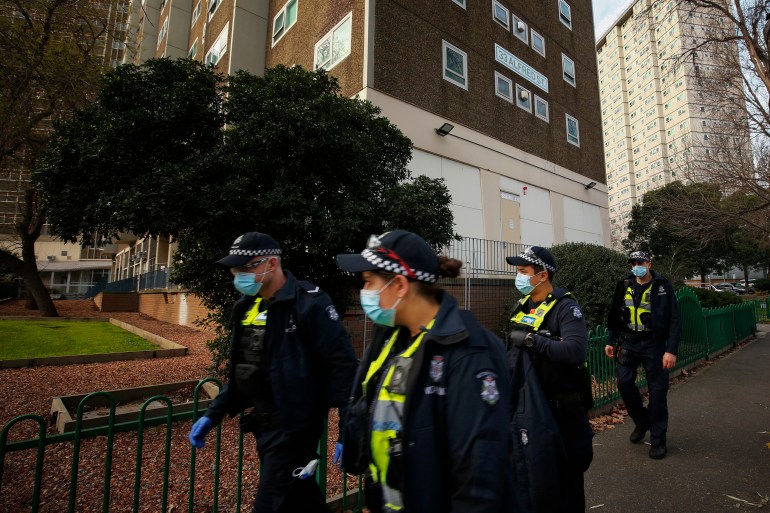
On that occasion, the community banded together to provide hot meals and other essential services to their neighbours. Much of the coordination was done through a mosque across the road from their homes.
“This mosque – the community built it,” Sara said. “We all chipped in and bought the land. It’s a special place for me.”
Last year, The Age newspaper reported that the mosque was facing challenges securing permits to build a new community hall and basketball court amid opposition from property developers.
New apartments in the area can sell for well more than 1 million Australian dollars ($650,000).
A place to call home
The government says that as a result of the demolitions, public housing tenants will get to live in “modern, fit-for-purpose housing that every Victorian can be proud to call a home”.
Instead of public housing, the new housing being offered is known as community housing, which Bassini says is managed by many different rental providers and does not provide the same “rights that people have living in public housing”.
In Carlton, close to the city’s universities, private developers have already built mixed-community and private housing on the grounds of land once reserved for public housing.
Some residents have also been told they have a better chance of keeping their families together if they agree to move to locations further out of the city, according to Bassini. Such a move would not only cut them off from their existing communities but also make it harder for them to access key services.
Sara acknowledges that some public housing buildings need repairs and that some, though not necessarily all, would be better demolished and rebuilt.
But she is wary that public housing is being replaced with homes that will be built by private developers.
“As long as you privatise, obviously, that’s horrible because; we’ll have nothing to come back to,” she said.
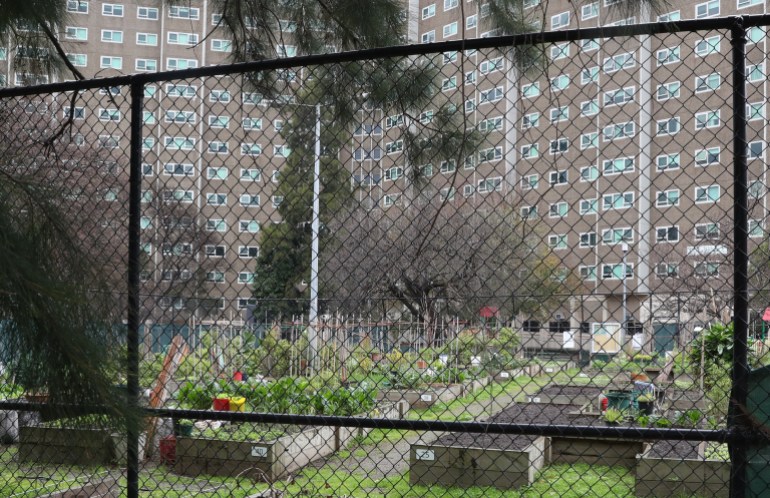
There are also questions over whether the plan will deliver more affordable housing in Melbourne, which recently overtook Sydney as Australia’s largest city.
The government says the renewal will boost “social housing by at least 10 percent”, a modest increase in a city where there is already a huge gap in affordable housing.
According to Australian census data, the percentage of Australian households who rent their home from a state or territory housing authority dropped from 6 percent in 1999-2000 to 3 percent in 2019-2020.
In the state of Victoria, the share of housing classified as public or community housing, is just 2.8 percent.
By comparison, in Paris and Vienna, the share of public housing has increased since the 1990s, with about 25 percent of the population of both cities now living in socially-rented housing.
“The perfect idea would be for them to rebuild and keep it public, And whoever wants to come back can come back and anyone new can come in,” said Sara.
“But the government’s… obviously, that’s not their plan. It doesn’t seem like that’s their plan.”
*Since residents of the tower are already in the process of being relocated to new housing, Al Jazeera agreed to use a pseudonym for Sara
Read More: World News | Entertainment News | Celeb News
Al Jazeera

